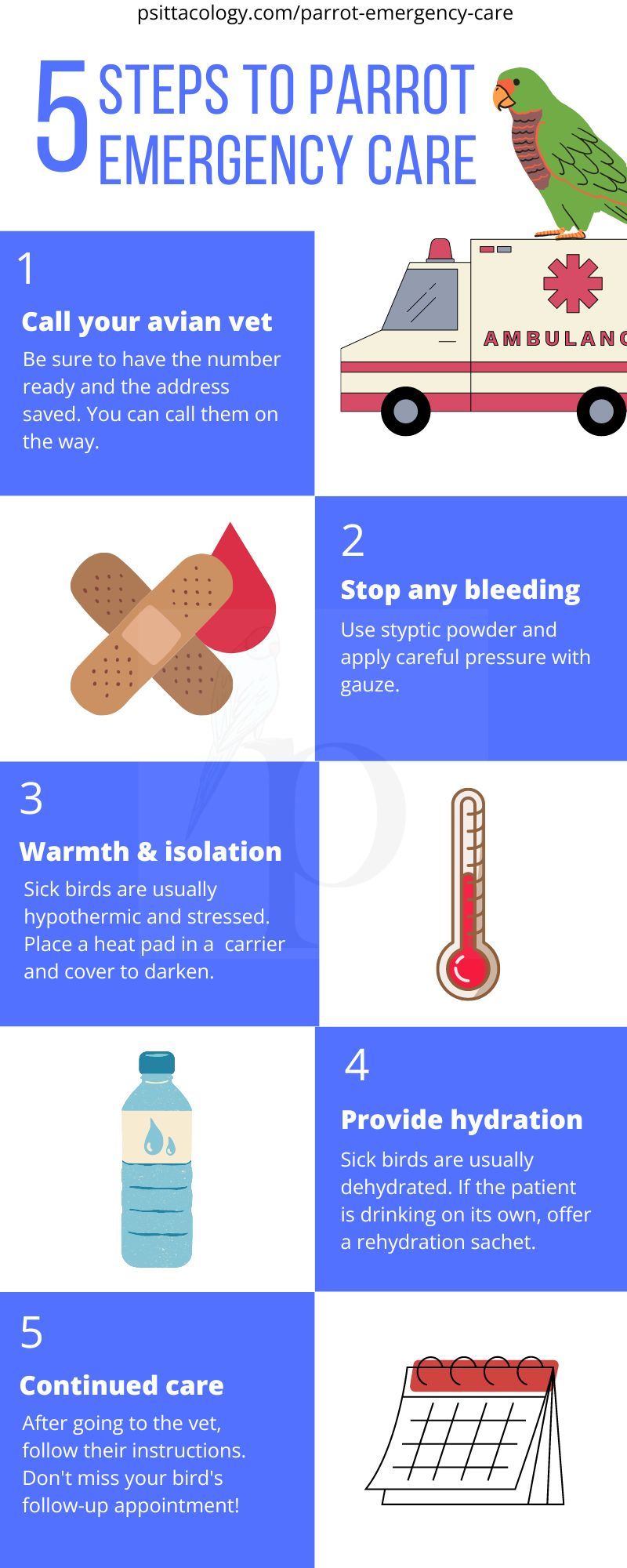Our feathered friends getting ill or injured is something no parrot parent wants to think about. Unfortunately, we have to, because properly preparing for an emergency can make the difference between life and death!
Do you know what to do if your parrot is bleeding? Do you have the number for an avian vet saved in your phone? Do you have a parrot first aid kit in your home?
If the answer to one or more of these is no, or if you’re preparing to add a parrot to your family and want to know what you should keep in mind, keep reading. We’ll discuss everything you need to know about dealing with a sick or injured parrot for the best chances of survival and recovery.
If your parrot is currently experiencing a medical emergency, stop reading. If it’s clearly urgent (trouble breathing, non-responsive, etc.), get your bird in a carrier now and call the vet on the way. If you’re not sure, call the vet from your home and describe what happened so they can tell you what to do.
If there is no vet available, you can scroll down to the section on “while you wait for the vet”, though I still recommend to keep trying different clinics in the meantime.
Preparing for emergencies
Prevention is better than cure, so we’ll start with that. The most important thing is to find an avian vet (they must have experience with birds) and get acquainted with them before anything happens.
You should have the vet’s number saved in your phone. Additionally, consider maintaining an emergency vet fund or getting insurance for your bird, because treatments can get very expensive.
Aside from this, there are three main things you can do to prepare for a parrot health emergency. With the boxes below ticked, you can hopefully prevent emergencies altogether. If not, it will at least help you to stop the situation from escalating.
Parrot safety
First off, prevention. Long-time parrot owners probably know the ropes already, although it’s still a good idea to check the best practices from time to time to make sure you haven’t forgotten anything.
If you’re preparing to get your first parrot, one of the most important things to learn is that these intelligent birds are extremely curious. They’re also extremely sensitive. This unfortunately makes them very prone to getting themselves in trouble!
Sometimes it seems like a parrot’s only goal in life is to get itself hurt: chewing power cables, nibbling on toxic plants, getting stuck in tight spaces, escaping through a cracked window, never to return…
Because of this, your bird should only have access to spaces in your house that are “parrot-proofed”. This includes things like: all doors and windows are closed, no other pets have access to the space, and you’ve removed all toxic or dangerous items.
Tip: Don’t forget to “parrot-proof” your bird’s own cage either. Some parrot toys found for sale aren’t actually safe, or can become unsafe when they begin to fall apart. Not to mention the importance of cage hygiene!

Parrot first aid kit
If there’s one thing I’ve learned over the years, it’s that no matter how cautious you are, your parrot can still get hurt. Accidents unfortunately just happen so easily: your bird’s toe gets stuck in a door, or it flies into a mirror, or maybe a blood feather breaks and triggers bleeding…
None of this is meant to scare you. I’m just trying to say that it helps to be prepared! One of the best things you can do is to put together a little avian first aid kit and keep it in an easy-to-access location.
The first aid kit should at least include:
- Your avian vet’s phone number(!!!)
- Styptic (blood clotting) powder
- Gloves
- Tweezers
- Bird-safe antiseptic (such as povidone-iodine)
- Gauze
- Scissors
- Syringe
- Cotton balls and buds
- Hydration sachets
- Bandage
- Magnifying glass
- Heating pad
Additionally, you should have a carrier ready in case you have to rush off to the vet. It should be small, lined with paper towels, and have the option to darken it (like by covering it).
Make sure everyone in your home knows where the first aid kit and carrier are, and knows how to use at least the basics, especially blood clotting powder. Parrots don’t have that much blood, so time is of the essence when an injury happens.
Dr. Daisy May, Psittacology’s resident veterinarian, says: Around 10% of your bird’s bodyweight is blood (for example, a 100g cockatiel has around 10mls of blood), and only 10% of this blood can safely be lost. For our 100g cockatiel, this means losing more than 1ml of blood has the potential to be dangerous.
Common symptoms of illness
Do you know what a parrot looks like when it’s sick or in pain? Unfortunately, like most other animals, our birds are very good at hiding their symptoms. In the wild, this helps them avoid getting eaten by predators, but in our homes, it can sometimes mean we don’t realize something is wrong.
The most important thing is to get to know your bird in its healthy state. How does it respond to you? How does it act in general? How does it look, sound, smell? What do its normal poops look like? This way you’ll know when something is off.
Veterinarian Dr. Daisy May recommends calling your vet to ask whether you should come in immediately or make an appointment for later if you see the following:
- Puffed up but otherwise bright
- Nasal discharge (though no trouble breathing with closed beak)
- Unusually watery or discolored poops
- Watery eyes
- Sneezing
- Small wounds that are NOT actively bleeding (like a broken toe nail)
- Agitation
- Wheezing
- Vomiting (once)
- Blood in poop*
*Consider whether your bird has eaten beetroot or bell pepper recently, as those can make its droppings look “bloody”.
Dr. Daisy recommends going to the avian vet without waiting (you should call while en route) if your parrot shows the following symptoms. It likely needs oxygen, to be placed in a warmed brooder, and to be given fluids orally or even intravenously.
- Puffed up and not moving much
- Wheezing
- Open-beaked breathing (trouble breathing)
- (Bleeding) wounds or trauma
- Inability/refusal to perch
- Panting or gasping
- Balance issues
- Seizure
- Unable to bite
- Unresponsive/eyes closed
- Blood in poop
- Refusing to eat
- Vomiting more than once
- Body parts in unnatural positions*
- Unable to pass an egg
- Fleshy bulge sticking out of the vent (prolapse)
*I once woke up to find my budgie’s head stuck at an angle. I rushed to the vet so he could be examined, receive anti-inflammatory medication, and more. He eventually made a full recovery. Don’t wait, see a vet!
Tip: Taking your parrot for a twice yearly health check-up is a fantastic preventative measure. It helps detect any problems early, including stuff like nutrient imbalances.

While you wait for the vet
So you’ve called your vet, but you’ve got a long car ride ahead or your parrot can’t be seen immediately for some other reason? You’ll have to provide some basic emergency care yourself. It can make the difference between life and death for your bird!
Stay calm. Take a deep breath. Here’s what you should do:
Stop bleeding
If your parrot is bleeding, stopping it is obviously your first priority. You should use styptic powder and apply pressure using some clean gauze for a few minutes.
If the wound is deep enough to have gone into a body cavity (that is, into the abdomen or thorax) then don’t bother applying styptic powder. Instead, apply pressure using clean gauze whilst on the way to the vet. Get there right away, without delay!
Birds have pretty good clotting abilities, so the above should usually stop any bleeding. If it doesn’t, you should continue applying pressure until the vet can see your bird.
When applying pressure, always be very careful not to restrict your bird’s ability to expand their chest as they breathe. Birds don’t have a diaphragm, so unlike us, they rely completely on being able to expand their chest wall to breathe.
Isolation & warmth
Stress and shock are huge bird killers, especially when they’re sick or injured. Vets go “hands off” with severely distressed and ill parrots for this reason: even just handling them can stress them out too much, which may be fatal for an already compromised bird.
Additionally, parrots in dire conditions usually aren’t able to properly keep themselves warm. They need supplemental warmth: 85 °F/29 °C is considered ideal.
To provide isolation and warmth, take a carrier or clean box and line it with kitchen paper or towels. Place a covered heat pad or a wrapped hot water bottle inside and cover the enclosure to darken it (microwavable heat pads are safest, as hot water bottles can burst). You can transport your bird to the vet in this container.
Rehydration
If you’ve spotted vomiting or diarrhea, your parrot may be dehydrated already. Moderate or severe dehydration absolutely needs to be addressed by your veterinarian without delay, but mild dehydration is something you can help with yourself at home.
To figure out how dehydrated your bird is, you can check the basilic wing vein refill time. You’ll need to identify your bird’s basilic wing vein, which is visible as a raised blue line that runs across your bird’s “elbow” (technically, the humeral-radioulnar joint) on the inside of their wing.
Next, press on the vein with a finger; this squishes the vein, momentarily displacing the blood from the spot where you are pressing. In a normal, well-hydrated bird, the vein should refill immediately when you lift your finger. In a dehydrated bird, the refill will be slower.
If it takes more than 2 seconds for the vein to refill when you lift your finger, this indicates your bird is experiencing moderate-severe dehydration and needs a vet ASAP. Even without using the basilic wing vein refill time, it’s safe to assume that a very sick bird is likely to be severely dehydrated.
Your parrot first aid kit should include rehydration sachets, which you can prepare according to the guidelines on the package and offer to your bird. Unfortunately, birds that are very sick are unlikely to be interested, which is one of the reasons it’s so important to get to a vet.
Mildly dehydrated birds that are still bright and able to swallow comfortably can be offered the rehydration solution on a teaspoon or in a syringe, especially if they are syringe trained.
Here’s how you do it:
Any fluids offered should be gently warmed to body temperature, to avoid the risk of making your bird colder. After all, as we’ve mentioned, sick birds will struggle more to maintain a normal body temperature.
If your parrot isn’t drinking by itself, there isn’t much you can do. Unless a qualified individual such as an avian vet, technician, or nurse has shown you how to safely administer fluids directly to the back of your bird’s mouth (avoiding the entrance to the windpipe) and you are fully confident with this technique, we strongly recommend you avoid attempting to it. This is due to the risk of fluid getting into your bird’s lungs.

In conclusion, your absolute #1 priority if anything is wrong is to get your parrot to an avian veterinarian. Birds are incredibly fragile beings, and emergencies can unfortunately escalate quickly.
If you have any more questions or want to share your own experiences, feel free to leave a comment below. Do keep in mind that this is NOT the place to ask for emergency help.
Sources


